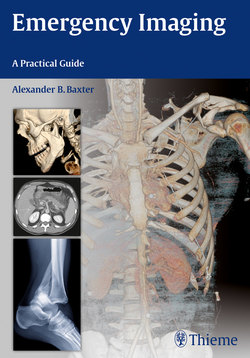Читать книгу Emergency Imaging - Alexander B. Baxter - Страница 119
На сайте Литреса книга снята с продажи.
Оглавление107
3 Head and Neck
◆Mandible Fracture
Mandible fractures are classified by ana-tomical location: condyle, coronoid process,subcondyle or ramus, angle, body, symphy-sis/parasymphysis and alveolus. Because themandible is functionally a ring, fractures of-ten occur at two sites or at a single bony sitewith associated temporomandibular joint(TMJ) separation. Frontal impact results insymphyseal fractures, while lateral impact,typical of assault injuries, leads to condy-lar, angle, or body fractures. Facial swelling,dental malocclusion, trismus, and intraoralbleeding are common clinical findings.
Oblique radiographs or panoramic to-mography can identify most mandible fractures. CT, which is usually available in the emergency setting, has the benefit of detecting any associated facial fractures and concomitant intracranial injury. The
cortical margin of the entire mandible should be examined for discontinuity.
“Favorable” fractures are located more posteriorly at the superior mandibular margin and more anteriorly at the inferior margin; these fractures tend to be held in alignment by the pterygoid muscles. “Un-favorable” fractures, which have the oppo-site orientation, are distracted by normal muscular forces. A fracture that enters the root of a tooth is considered an open fracture, and these patients will require antibiotics.
Treatment depends on the location and conformation of the fracture and can consist of either immobilization by maxil-lomandibular fixation, with arch bars and wiring, or by open surgery with miniplate fixation (Fig. 3.11).
Fig. 3.11a–ga–c Mandible anatomy and fracture orientation: (a) (1) condyle, (2) coronoid process, (3) subcon-dyle or ramus, (4) angle, (5) body, (6) symphysis/parasymphysis, (7) alveolus. (b) Favorable orientation. (c) Unfavorable orientation.
d–g Left condylar and right parasymphyseal fractures. The left mandibular condyle is laterally angulated and displaced with respect to the left body. The left body and symphysis are displaced to the left as a result of unopposed muscle pull from an “unfavorable” right parasymphyseal fracture.
